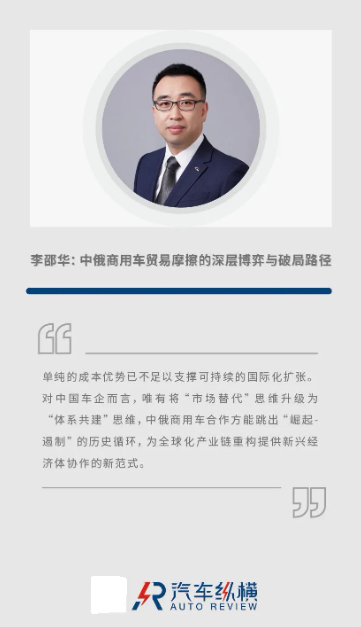In-depth Analysis and Breakthrough Path for Sino-Russian Commercial Vehicle Trade Friction
![]() 03/04 2025
03/04 2025
![]() 465
465

Author | Li Shaohua
Typesetting | Zheng Xueqin
Design | Guo Qing
This article serves as the "Editorial" for the March 2025 issue of "Auto Review" magazine. The author holds the position of Deputy Secretary-General at the China Association of Automobile Manufacturers.
On February 6, Russian Minister of Industry and Trade Anton Alikhanov publicly criticized three Chinese commercial vehicle brands for "safety defects," subsequently suspending the sales qualifications of the affected models. While this incident appears to be a straightforward dispute over product quality, it actually underscores the intricate game between emerging industrial nations and traditional markets amidst the restructuring of the global industrial chain.
Firstly, the event's backdrop: the dual impetus of industrial protection and market imbalance.
The Russian commercial vehicle industry faces a hollowing-out crisis. Historically reliant on Western technological cooperation, Russian local brands saw their production capacity plummet after the rupture of European and American supply chains following the Russia-Ukraine conflict. Chinese commercial vehicles swiftly capitalized on their cost advantage, rapidly increasing their market share from 10% pre-conflict to approximately 70%, directly compressing the survival space of local enterprises. The Russian government's accusation of "safety defects" is essentially an attempt to buy time for local enterprises to undergo transformation and delay the market expansion of Chinese automakers.
Chinese commercial vehicles face structural challenges in their internationalization process. In 2024, Chinese brand vehicle exports to Russia totaled 1.158 million units, accounting for nearly 20% of China's total vehicle exports. Among these, 120,000 were commercial vehicles, an elevenfold increase from 2021. However, this rapid growth is accompanied by hidden dangers:
Differences in certification standards: The Russian OTTC certification encompasses complete vehicles, engines, and key components, requiring adherence to GOST standards and EAEU technical regulations. There is no mutual recognition of vehicle certifications between China and Russia, and standards vary in areas such as noise control, extreme cold adaptability, emission standards, and the mandatory installation of the ERA-GLONASS system (Russian satellite positioning system). Failure to accurately understand and strictly implement these standards poses a high risk of non-compliance for domestic enterprises.
Insufficient industrial chain localization: In 2019, Russia issued Decree No. 719, "On Approving the Standard Terms of Special Investment Contracts in the Field of the Automotive Industry," aiming to promote localization of automotive industry technology and reassert sovereignty over the industrial chain through measures including investment, technology transfer, subsidies, and raw material localization. Given concerns over US and European sanctions on Russia, Chinese commercial vehicle enterprises' local investments fall short of the targets set by Decree 719.
Externalization of internal competition: Chinese commercial vehicle products in Russia are priced between European and local products. As domestic commercial vehicle enterprises scale up their exports, prices continue to decline. Notably, before October 2024, to avoid an impending increase in scrap taxes, the inventory of commercial vehicles surged, leading to more disorderly price competition, which seriously threatens the survival of local enterprises.
Secondly, the underlying forces: the intricate interplay of economic sovereignty and industrial competition.
Russia's "Industrial Chain Reconstruction" strategy: Russia is reasserting its sovereignty over the automotive industry through three strategies: upgrading policy barriers by annually increasing scrap taxes by 10%-20%, weaponizing technical standards by using the EAEU certification system to demand key core technology transfers from Chinese enterprises in exchange for market access, and leveraging market for technology by encouraging leading Chinese enterprises to establish joint ventures with local brands, thereby bridging production capacity gaps and obtaining technology transfers.
The need to rebalance the Sino-Russian trade structure: In 2024, Sino-Russian trade volume exceeded $240 billion, but the automotive trade surplus was disproportionately high. Through the quality dispute incident, Russia seeks to regain bargaining power in non-energy sectors, pressuring China to increase local investments.
Thirdly, the breakthrough path: transitioning from product output to system co-construction.
Regulating competition: sharing development opportunities. Enhance product compliance, strengthen industry self-discipline, avoid disorderly price competition, maintain the reputation of enterprises and products, and engage in differentiated competition with Russian local products.
Technical standard coordination: building a Eurasian certification community. Promote mutual recognition of standards and certifications between China and Russia, jointly develop industry standards in new fields like autonomous driving and hydrogen-powered heavy trucks to prevent redundant technical barriers, and establish joint laboratories to provide certification services and expedite the certification process.
Deep integration of the industrial chain: a win-win model of technology for the market. Grasp global political trends, encourage domestic enterprises to form joint ventures and collaborations with Russian local enterprises, share electric drive platforms and intelligent technologies, and gradually increase localization rates.
Service ecosystem innovation: addressing the "after-sales black hole." Develop an after-sales platform to ensure full-process traceability of parts. Collaborate with local Russian scientific research and industrial technology institutions to establish a polar engineering technology center, focusing on technologies such as special lubricants for -50°C conditions and low-temperature battery adaptability.
This friction highlights the reality that emerging industrial countries must confront during their ascent: a simple cost advantage is no longer sufficient to sustain international expansion. For Chinese automakers, transitioning from a "market substitution" mindset to a "system co-construction" mindset is crucial for Sino-Russian commercial vehicle cooperation to transcend the historical cycle of "rise-suppression" and provide a new paradigm for collaboration among emerging economies amidst the restructuring of the global industrial chain.

Picture: Auto Review
Article: Auto Review
Typesetting: Auto Review







